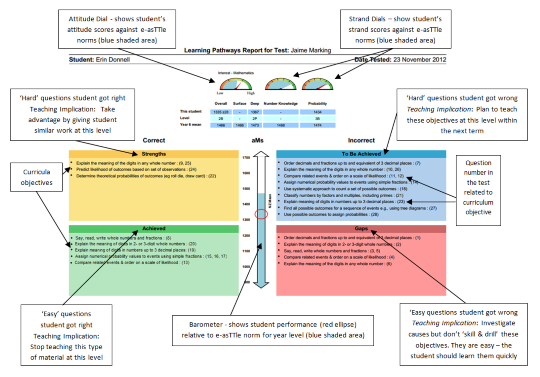Understanding a reading or maths Individual Learning Pathway (ILP)
For the latest information using the upgraded e-asTTle tool, visit e-asTTle - Reports on Tāhūrangi.
This report addresses the question “What are the strengths and weaknesses of individual students?”.
Be aware the ILP does not consider the student’s year level.
Thus, a strength for a Year 4 student means the student is performing significantly better than expected in that curriculum area, given their overall performance. It does not imply that the student is achieving well beyond Year 4 in that curriculum area.
Read a text version of this image.
Extra notes
Because the questions relating to a single objective may be of varying curriculum levels, the same objective can be listed in multiple quadrants.
A question may appear more than once in the same quadrant. This is because a question may have more than one objective associated with it.
If the test was adaptive, the question number is prefixed with the stage number. For example (1:4) indicates question number 4 of stage 1.
Further information about the ILP Quadrants
Achieved
Questions that, given your student’s overall e-asTTle score (in the appropriate curriculum area), should have been answered correctly and were. These are areas in which you can feel confident in giving your student more challenging work.
Strengths
Questions that were expected to be answered incorrectly, given your student’s overall e-asTTle score but were answered correctly.
These questions are more difficult than a student's overall ability. However for reading, it is possible for a student to have correctly guessed the answer to questions that would normally be outside their ability range.
While such responses will be excluded from the student’s level calculation, the questions will still display in the Strengths box.
Teachers use their overall judgment in determining whether these questions represent guessing behaviour or a student’s unexpected strengths that should be exploited in future teaching and learning.
Gaps
Questions that, given your student’s overall e-asTTle score should have been answered correctly but were incorrect.
These are questions that would be expected to be relatively easy for the student.
This is an area where you should investigate to determine the reason. It may be due to carelessness, skipping questions, illness, or not having being taught it yet.
Investigate to determine whether or not it is a true concern.
To Be Achieved
Questions that were expected to be answered incorrectly, given your student’s overall e-asTTle score, and were answered incorrectly. These questions signify areas that your student has yet to achieve and in which it is expected you will carry out more teaching.
Report showing a dash
A dash indicates that e-asTTle could not generate a score.
If your student gets fewer than three questions correct in a strand or the test, e-asTTle will not be able to generate the appropriate score.
Reading and Maths tests have an additional guessing function. In some cases, a student may have answered three questions correctly but still have a dash because some of their correct answers were removed as likely guesses.
StudentSpeak Individual Learning Pathway
The StudentSpeak Individual Learning Pathway option is available for reading and maths.
The report contains objectives written in simplified language to help students understand their report. Each objective links to extra information. This can be an example question, to show what the objective might look like in a test, or a more detailed explanation of the objective.
See the list of curriculum objectives for each subject.
- Related information


